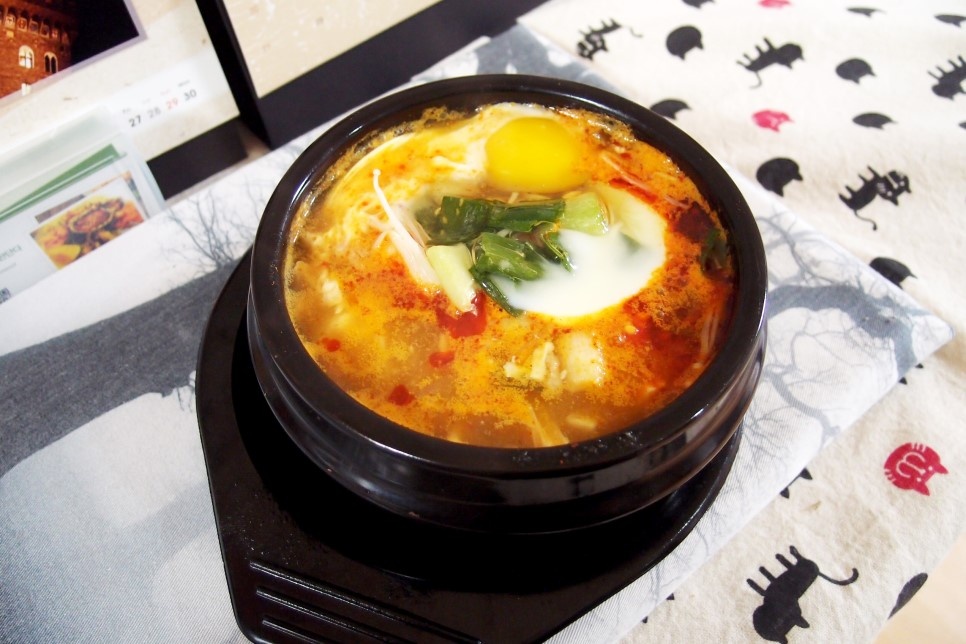All-Purpose Seasoning Paste for Sundubu Jjigae
#Sundubu Jjigae Made with Homemade Chili Oil #Quick and Easy Sundubu Jjigae with All-Purpose Seasoning Paste~ Simmering Deliciously!

I quickly made Sundubu Jjigae using an all-purpose seasoning paste I had prepared beforehand. This isn’t Baek Jong-won’s recipe; it’s my own special blend. Instead of sugar, salt, or soy sauce, I used pear juice and plum extract for sweetness. For saltiness, I relied on anchovy extract, giving the paste a delightful depth of flavor. This paste significantly cuts down cooking time while delivering a rich taste.
Stew Ingredients- 1/2 cup minced pork (approx. 75g)
- 1/2 cup chopped green onions
- 1/2 onion, minced
- 1 bunch enoki mushrooms
- 1 package soft tofu (sundubu)
- 1 egg
All-Purpose Seasoning Paste Ingredients- 2 Tbsp gochugaru (Korean chili flakes)
- 1 Tbsp minced garlic
- 1 Tbsp anchovy extract (or fish sauce/soup soy sauce)
- 1 pack pear juice (approx. 100ml)
- 2 Tbsp plum extract
- 1 tsp minced ginger (optional)
- 2 Tbsp gochugaru (Korean chili flakes)
- 1 Tbsp minced garlic
- 1 Tbsp anchovy extract (or fish sauce/soup soy sauce)
- 1 pack pear juice (approx. 100ml)
- 2 Tbsp plum extract
- 1 tsp minced ginger (optional)
Cooking Instructions
Step 1
To add depth of flavor, start by placing a piece of dried kelp (dashima) in cold water and bring it to a boil. Once the water boils, remove the kelp. You can then dissolve a small amount of doenjang (soybean paste) into the broth to create a clear base. (Prepare about 2-3 cups of water for the broth.)

Step 2
Prepare the vegetables for the stew. If you have napa cabbage, chop it into bite-sized pieces. If using canned tuna, drain the oil or water thoroughly using a sieve. Slice the green onions diagonally.

Step 3
Introducing my homemade all-purpose seasoning paste for Sundubu Jjigae! The golden ratio is 2 parts gochugaru, 1 part minced garlic, and 1 part anchovy extract, enhanced with minced ginger, plum extract, and pear juice for sweetness. Letting it age in the refrigerator develops an even richer flavor. It’s incredibly convenient for quick braised dishes or when making Sundubu Jjigae.

Step 4
Prepare the minced pork, which adds a delicious savory note to the stew. About 1/2 cup is sufficient to enrich the broth.

Step 5
Have your soft tofu (sundubu) ready. One package is usually enough for 1-2 servings.

Step 6
Finely mince half an onion. The natural sweetness of the onion will further enhance the stew’s flavor.

Step 7
Now, let’s start cooking the stew! In a pot, add the chopped green onions and a little cooking oil or perilla oil. Sauté over medium-low heat until fragrant, releasing the aromatic green onion oil. This step significantly boosts the stew’s flavor profile.

Step 8
Once the green onions are fragrant, add the minced pork and stir-fry together. Ensure the pork is well distributed as it cooks.

Step 9
When stir-frying the minced pork, it’s important to break up any clumps with your spatula so it cooks evenly. You’ll notice a savory aroma developing as the pork browns.

Step 10
When the pork is partially cooked, add 2-3 tablespoons (adjust to your taste) of the prepared all-purpose seasoning paste and stir-fry together. As the paste and pork meld, the chili oil will naturally render, giving the stew its appetizing red color and spicy aroma.

Step 11
Add a pinch of black pepper to eliminate any gamey odors and add a touch more flavor. Be careful not to add too much.

Step 12
Next, add the minced onion and stir-fry it with the pork and seasoning paste. Sauté until the onions become translucent and release their sweetness, which will deepen the overall flavor of the broth.

Step 13
Once the pork and seasoning paste have rendered enough chili oil, pour in the prepared broth (or plain water) and bring to a boil. Since the pork adds plenty of savory flavor, you can use plain water instead of a separate broth. Reduce the heat to medium once the stew begins to boil vigorously.

Step 14
When the broth is boiling rapidly, gently add the soft tofu (sundubu) in large chunks using a spoon. Avoid stirring too vigorously after adding the tofu to maintain its soft texture.

Step 15
I haven’t added extra seasoning yet because the anchovy extract in the paste provides sufficient saltiness. After the tofu has simmered for a bit, taste the stew. If you find it too bland, adjust the seasoning with a small amount of salt or more anchovy extract, according to your preference.

Step 16
The Sundubu Jjigae has developed a beautiful, appetizing color, and the broth has thickened nicely. Break the soft tofu into large, manageable pieces with a spoon. Be careful not to break it down too finely, as this can make the stew cloudy.

Step 17
As the stew nears completion, prepare the enoki mushrooms to be added as a garnish. Trim the base and separate the mushroom strands.

Step 18
Finally, when the stew is boiling again, gently place the prepared enoki mushrooms on top. They will cook quickly in the residual heat, so they don’t need to be simmered for long.

Step 19
To enjoy the stew at its best and warmest, I’ve transferred the finished Sundubu Jjigae to a traditional Korean earthenware pot (ttukbaegi). Ttukbaegi retains heat exceptionally well, keeping the stew piping hot for longer.

Step 20
Just before serving, add a bit more sliced green onion for extra freshness. Bring it to a rolling boil one last time over high heat and enjoy it piping hot! Sundubu Jjigae in a ttukbaegi is best enjoyed extremely hot. For an extra touch, you can gently place a raw egg yolk on top just before eating to let it cook in the residual heat.




